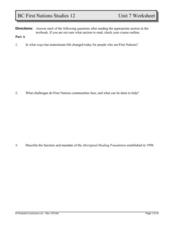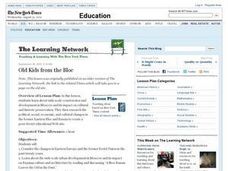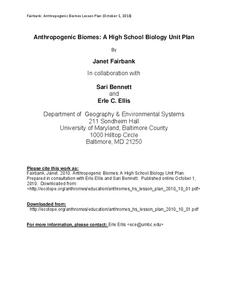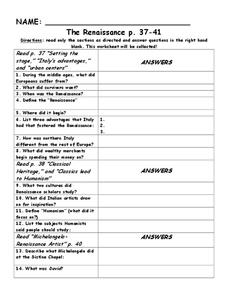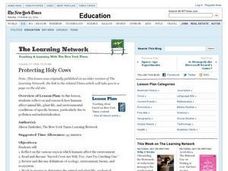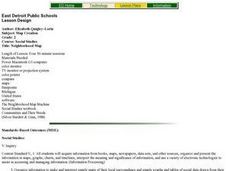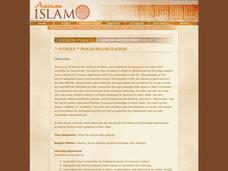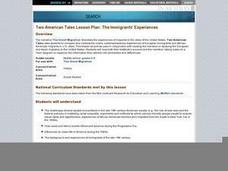Curated OER
BC First Nations Studies 12
If your class is learning about the economics, culture, and education options provided for the First Nations, then they'll love this task. They'll answer 32 discussion-based questions related to the rights, treatment, and policy that...
Curated OER
Communities
Students examine the similarities and differences between rural, suburban, and urban communities. They read about type of community in their social studies textbook, analyze the differences between Tokyo and Chicago, and complete a chart...
Curated OER
Coming to America: U.S. Immigration
Analyze primary source documents relating the conditions under with prompted American immigration. Learners will analyze information in order to create a six-panel pamphlet. Much of the lesson is not available but the key objectives are....
Curated OER
Glasgow - a case study 4
Students look at the inner-city and housing in Glasgow today and consider how the city has been redeveloped over time. They answer a GCSE question using Glasgow as the case-study. Students draw a timeline from the 1950s to the present...
Curated OER
Taking From the Giving Tree
Students explore the ways in which various American cities negotiate the protection of their "green infrastructure," gaining a broader understanding of proposed and enacted legislation as it relates to preserving and planting trees in...
Curated OER
Old Kids From The Bloc
Students study about wide scale construction and development in Moscow and its impact on cultural and historic preservation. They research the political, social, economic, and cultural changes in the former Eastern Bloc and create a...
Curated OER
Anthropogenic Biomes
If you teach a man to fish, he will never go hungry—or he will overfish and permanently damage the ecosystem? Address the traditional biomes as well as the human-included ecosystems and contrasts the biotic and abiotic factors in each....
Polk Bros Foundation
Answer the BIG Question with Cited Examples and Evidence
Close up your unit of study with an examination of one of the guiding or essential questions as it relates to what your class has studied and other research. Class members first write down the question. Then they note down information...
Curated OER
Gwynns Falls
Students investigate the question: What is the impact of urban development and expansion on the health of a decidious forest ecosystem and humans? They examine the issue of land development by responding to a specific scenario and...
Curated OER
The Renaissance
In this Renaissance study guide worksheet, students respond to 14 short answer questions. The questions correlate to assigned readings in a textbook.
Curated OER
Chapter 13 – Progressivism
In this U.S. history worksheet, students read assigned textbook pages regarding Progressivsim and respond to 48 short answer questions.
Historical Thinking Matters
Scopes Trial: 1 Day Lesson
Why did many Tennesseeans support the 1925 Butler Act, which forbade the teaching of evolution? Using several primary source documents and a brief video clip, your young historians will draw connections between the broader historical...
Curated OER
North or South? Which has a better way of life?
Sixth graders brainstorm what they believe are the causes of the Civil War. They copy the blank circle graph into their Social Studies journals twice once for their prediction and once for the actual. Students list the following...
Curated OER
Protecting Holy Cows
Students study the interrelationships of organisms and their environments. They study ecological communities and determine what is necessary for survival. Students discuss and answer questions concerning a group's biome, habitat, food...
Stanford University
Settlement House Movement SAC
Young scholars read and view a movie on Social Gospel and Settlement Houses. In this Social Reform lesson plan, students view the movie, read the passages and answer questions on the social reform movement of this time.
Curated OER
Map Creation
Second graders identify a map, symbol, key, and compass rose. Students create and print a map for teacher evaluation using the computer. Students identify the symbols on their map and orally present them to the class.
Curated OER
Qur'an: Sacred Scripture of Islam
Students discover the strong emphasis Islam puts on education. Using the Internet, they identify advancements in ethics, math and astronomy. They explain the importance of madrasahs, or traditional places of learning in Islam, and...
Curated OER
This Land Is My Land
Students explore their impressions of African history, focusing on black/white relations. They examine the impact of the recent election on Zimbabwean politics by reading and discussing the article "Vote in Zimbabwe Shows Opposition...
Curated OER
The Founding of Los Angeles, California
Seventh graders examine the social and cultural impact of settler groups in California and the origins of the founding of Los Angeles, California. They read and discuss an informational handout, and discuss what it is and was like to...
Curated OER
Building Relations
Students examine the relationships between particular landmarks and their home cities. They create posters illustrating the various connections and write scripts that could be used by tour guides.
Curated OER
The American Indian Movement
Twelfth graders examine the civil rights movement of the Native Americans. They read the provided multicultural reading passage and answer the questions that follow. They chart which cultural groups fought for equal rights during the...
Curated OER
Who Built the Pyramids?
Students examine the two theories on how the pyramids at Giza were built. They watch a video on pyramids, take notes, and write a five-paragraph essay on how they think the pyramids were constructed.
Curated OER
Hatshepsut's Temples and Obelisks
Third graders create Hatshepsut's Temples and Obelisks using a variety of materials.
Curated OER
The Great Migration: Two American Tales
Young scholars compare and contrast experiences of European immigrants and African American migrants in U.S. cities. After examining the topic, they write essays evaluating the differences and similarities of the groups' experiences.


